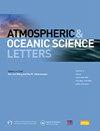El Niño-Southern振荡对2000-2023年全球火灾PM2.5的影响
IF 3.2
4区 地球科学
Q3 METEOROLOGY & ATMOSPHERIC SCIENCES
引用次数: 0
摘要
El Niño-Southern涛动(ENSO)是全球气候变率的关键驱动因素,深刻影响区域火灾活动和相关污染物排放。本文研究了2000-2023年ENSO对全球火灾排放和火灾诱发PM2.5浓度的影响。在厄尔尼诺Niño事件期间,由于异常变暖和降水不足,全球火灾排放量增加了5.9% - 20.0%,其中印度尼西亚、北美和澳大利亚是区域热点。相比之下,La Niña事件导致全球火灾排放量减少3.2% - 9.9%,区域差异取决于所使用的火灾清单。因此,火灾引起的PM2.5浓度在厄尔尼诺Niño期间大幅增加,印度尼西亚上升27.5% - 71.0%,北美上升49.2% - 116.5%,澳大利亚上升17.5% - 42.6%。相反,La Niña事件在这些地区分别导致26.6% - 52.5%、19.4% - 37.3%、14.5% - 24.4%的下降。这些发现强调了ENSO在从区域到全球范围内塑造火灾排放和空气污染方面的关键作用,为减轻极端气候对空气质量的影响提供了有价值的见解。摘要厄尔尼诺——南方涛动(ENSO)是全球气候变化的主要驱动因素,对区域火灾活动及其相关污染物排放有深远影响。。在厄尔尼诺事件期间,由于异常增温和降水不足,全球火灾排放增加5.9%−20.0%,其中印度尼西亚、北美和澳大利亚为火排放增幅最显著地区。相比之下,拉尼娜事件期间全球火灾排放减少3.2%−9.9%,具体变化取决于所使用的火灾排放清单。在此背景下,火灾引起的PM2.5浓度在厄尔尼诺事件期间显著增加,印度尼西亚增加27.5%−71.0%,北美增加49.2%−116.5%,澳大利亚增加17.5%−42.6%;而在拉尼娜事件期间,这些地区的PM2.5浓度分别减少26.6%−52.5%,19.4%−−24.4% 37.3%和14.5%。研究结果表明,ENSO从区域到全球尺度上深刻影响着火排放和空气污染物浓度,相关结论为减缓极端气候事件对空气质量的影响提供了重要的科学依据。本文章由计算机程序翻译,如有差异,请以英文原文为准。

Impacts of El Niño–Southern Oscillation on global fire PM2.5 during 2000–2023
The El Niño–Southern Oscillation (ENSO) is a key driver of global climate variability, profoundly influencing regional fire activities and associated pollutant emissions. This study investigates the impacts of ENSO on global fire emissions and fire-induced PM2.5 concentrations in 2000–2023. During El Niño events, global fire emissions increase by 5.9 %–20.0 % with regional hotspots in Indonesia, North America, and Australia, driven by anomalous warming and rainfall deficits. In contrast, La Niña events result in a 3.2 %–9.9 % reduction in global fire emissions, with regional variability depending on the fire inventories used. In response, fire-induced PM2.5 concentrations increase substantially during El Niño, rising by 27.5 %–71.0 % in Indonesia, 49.2 %–116.5 % in North America, and 17.5 %–42.6 % in Australia. Conversely, La Niña events lead to decreases of 26.6 %–52.5 %, 19.4 %–37.3 %, 14.5 %–24.4 % in these regions, respectively. These findings highlight the critical role of ENSO in shaping fire emissions and air pollution from regional to global scales, providing valuable insights for mitigating the impacts of climatic extremes on air quality.
摘要
厄尔尼诺-南方涛动 (ENSO) 是全球气候变化的主要驱动因素, 对区域火灾活动及其相关污染物排放有深远影响. 本研究分析了2000–2023年期间ENSO对全球火灾排放及火灾引起的PM2.5浓度的影响. 在厄尔尼诺事件期间, 由于异常增温和降水不足, 全球火灾排放增加5.9 %−20.0 %, 其中印度尼西亚, 北美和澳大利亚为火排放增幅最显著地区. 相比之下, 拉尼娜事件期间全球火灾排放减少3.2 %−9.9 %, 具体变化取决于所使用的火灾排放清单.在此背景下, 火灾引起的PM2.5浓度在厄尔尼诺事件期间显著增加, 印度尼西亚增加27.5 %−71.0 %, 北美增加49.2 %−116.5 %, 澳大利亚增加17.5 %−42.6 %; 而在拉尼娜事件期间, 这些地区的PM2.5浓度分别减少26.6 %−52.5 %, 19.4 %−37.3 %和14.5 %−24.4 %. 研究结果表明, ENSO从区域到全球尺度上深刻影响着火排放和空气污染物浓度, 相关结论为减缓极端气候事件对空气质量的影响提供了重要的科学依据.
求助全文
通过发布文献求助,成功后即可免费获取论文全文。
去求助
来源期刊

Atmospheric and Oceanic Science Letters
METEOROLOGY & ATMOSPHERIC SCIENCES-
CiteScore
4.20
自引率
8.70%
发文量
925
审稿时长
12 weeks
 求助内容:
求助内容: 应助结果提醒方式:
应助结果提醒方式:


